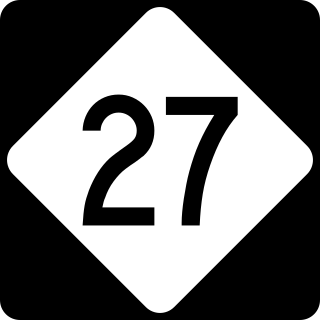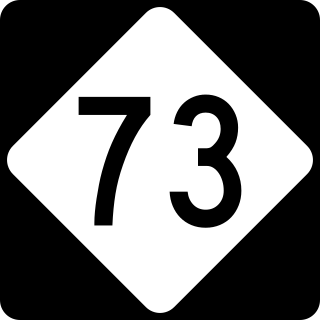Related Research Articles

Lincoln County is a county located in the U.S. state of North Carolina. As of the 2020 census, the population was 86,810. Its county seat is Lincolnton.

Lincolnton is a city in Lincoln County, North Carolina, United States within the Charlotte metropolitan area. The population was 10,486 at the 2010 census. Lincolnton is northwest of Charlotte, on the South Fork of the Catawba River. The city is the county seat of Lincoln County, and is the only legally incorporated municipality which is wholly within the county.

North Carolina Highway 27 (NC 27) is a primary state highway in the U.S. state of North Carolina. The route traverses 198 miles (319 km) through southern and central North Carolina, about 100 miles (160 km) of it as a concurrency with NC 24.

State Route 43 (SR 43) is a 25.7-mile-long (41.4 km) state highway that travels southwest-to-northeast through portions of McDuffie and Lincoln counties in the east-central part of the U.S. state of Georgia. The highway connects the northern part of the Thomson area to the South Carolina state line, via Lincolnton.
Gaston College is a public community college in Dallas, North Carolina. Serving Gaston County and Lincoln County, Gaston College enrolls over 5,000 students each term in curriculum programs and about 16,000 students in continuing education programs. It is part of the North Carolina Community College System and accredited by the Southern Association of Colleges and Schools to award associate degrees.

North Lincoln High School is a public school in Lincolnton, North Carolina, United States. North Lincoln was completed in 2003, and the total student population is approximately 1,050. The school mascot is the Knight, and the school colors are Royal Blue, Silver, and Black, with white as an accent color. The principal is Chip Cathey. Assistant principals are Lee Rice and Jason Cranford.

North Carolina Highway 73 (NC 73) is a primary state highway in the U.S. state of North Carolina that travels through south-central North Carolina in the United States. Most of the route is a two-lane highway that passes through both rural scenic areas; however, it also serves several small and moderate-sized cities in the state, including Concord and Albemarle. The western terminus of NC 73 is at an intersection with NC 27 east of Lincolnton and its eastern terminus is at a junction with US 15/US 501 in Eastwood.
Hyde County Schools is a public school district in Hyde County, North Carolina. Headquartered in Swan Squarter, currently operates two K-12 schools.
Lincoln County Schools is the School district that presides over all of Lincoln County, North Carolina.
Geoffrey Lloyd Preacher was an American architect. Based in Atlanta, Preacher and his firm specialized mostly in commercial offices, hotels, and apartment buildings in the Southeastern United States.

Lincolnton Recreation Department Youth Center was a historic clubhouse building located at Lincolnton, Lincoln County, North Carolina. It was built as a temporary school about 1921 and renovated and enlarged in 1947. It was a single-story wood-frame building with a truncated hipped roof in the Bungalow / American Craftsman style. It sat on an exposed basement at the rear, with brick, asphalt, and wood as its basic materials. The Center continued to function until 1989, but was demolished in August, 2019.
Stuart W. Cramer High School is a public high school in the Gaston County Schools district located in Cramerton, North Carolina. Its attendance range covers the central portion of eastern Gaston County and includes all of the towns of Cramerton and McAdenville and portions of Belmont and Mount Holly. Jessica Steiner serves as principal. Assistant principals include Brittany Beckham, Phillip Morris and Chris Gardner. Mike Patton serves as athletic director. The school was named for Stuart W. Cramer of Thomasville, North Carolina. Cramer was the founder of Cramerton, North Carolina, a leading industrialist in the textiles and air conditioning industries, and one of the founding partners of Duke Power.
Oberlin Academy Preparatory School, originally Oberlin Institute and then Preparatory Department of Oberlin College, was a private preparatory school in Oberlin, Ohio which operated from 1833 until 1916. It opened as Oberlin Institute which became Oberlin College in 1850. The secondary school serving local and boarding students continued as a department of the college. The school and college admitted African Americans and women. This was very unusual and controversial. It was located on the Oberlin College campus for much of its history and many of its students continued on to study at Oberlin College. Various alumni and staff went on to notable careers.
Pinellas High School was a public high school from 1934 until 1968 in Clearwater, Florida. It served African Americans from the surrounding area of northern Pinellas County including Largo, Clearwater, Dunedin, Safety Harbor and Tarpon Springs during the era of segregation. It was at 1220 Palmetto Street. During its existence, it was the first segregated school in the region and it was the only school exclusively serving Black students in Pinellas County.
Hamilton High School is a former school in Scottdale, Georgia that served African American students in Dekalb County, Georgia. It opened as Avondale Colored School, an elementary school, in 1924. It expanded to include a high school and was also known as Avondale Elementary and High School. It eventually closed after desegregation in 1969.
Lawrence Chesterfield Bryant was a professor, principal, pastor, and author. He wrote two books on South Carolina's 19th and early 20th century African American legislators. He was awarded the South Carolina Silver Crescent Award in 2005 for his research and work as an educator. Duke University has an extensive collection of his papers.
E. O. Douglas High School served African American students during segregation in Sebring, Florida. It was the only high school available to African Americans in Highlands County, Florida. Samuel C. Nixon was its principal from 1946 until it closed in 1970. The school was named for bank president and trustee Eugene Oren Douglas. It became an elementary school in 1967 and closed was closed with desegregation in 1970.
Louisburg High School is in Louisburg, North Carolina. The student body has a mix of white, African American, and Hispanic students. The school colors are orange and blue. Warriors are the school mascot.
Barnwell High School is a public high school in Barnwell, South Carolina. It has about 625 students. The Warhorse is the school's mascot.

Orange County Training School (OCTS) (1916–1948), later known as Lincoln High School (1948–1966), was a public elementary and high school that served African American students in Chapel Hill, Orange County, North Carolina. It became a Rosenwald School starting in 1924, one of the 800 or more in the state.
References
- 1 2 3 Howard, Wayne (September 4, 2017). "Newbold Reunion - Lincoln Herald". lincolnherald.net. Retrieved 2023-01-07.
- ↑ Harpe, Jason L. (January 7, 2004). Lincolnton: Photographs from the Clyde C. Cornwell Collection. Arcadia Publishing. ISBN 9780738516400 – via Google Books.
- 1 2 "Newbold High School Alumni Celebration Coming Up". Lincoln Herald. August 24, 2017.
- ↑ "The Negro Educational Review". Negro Educational Review, Incorporated. January 7, 1959 – via Google Books.
- ↑ Sanford), North Carolina Governor (1961-1965 (January 7, 1966). "Messages, Addresses, and Public Papers of Terry Sanford, Governor of North Carolina, 1961-1965". Council of State, State of North Carolina – via Google Books.
- ↑ Sr, Charles A. Shipp (September 6, 2011). A Poetic Climate. Xlibris Corporation. ISBN 9781465342676 – via Google Books.
- ↑ Harpe, Jason L.; Boles, Matt (August 15, 2016). Around Denver. Arcadia Publishing. ISBN 9781439657119 – via Google Books.
- ↑ Staff Writer. "Classmates gather for Newbold High School Reunion". Gaston Gazette.
- ↑ Writer, MICHELLE T. BERNARD Senior Staff. "Two seats up for grabs in Lincolnton City Council race". Lincoln Times News.